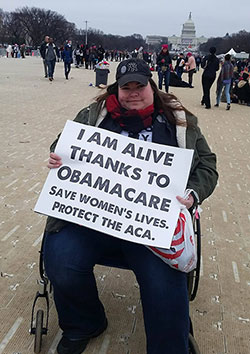- 27Shares
What does protest mean for disabled people, and how can we contribute through our lived experience or active engagement? I can’t access in-person marches or similar events, and sometimes I must completely disconnect from current events to stay healthy. It’s hard to find solace when our rights and safety are threatened, so I write when things become too much. That’s how I channel my anxious energy, and it works for me.
There is no right way to protest – one method does not count more than another. Protest is about building each other up in resistance to crisis. It’s about those with privilege filling the gaps while amplifying marginalized voices. “You’re not doing enough” shames those who may be struggling to get through another day, or who don’t have the means to contribute more of their time or energy. We don’t all have to show up and hold signs and tweet to be in a political movement. For those who bear the weight of oppression, our lives and bodies are inherently political, and surviving is a form of protest. Surviving can be enough.
Protest access is unique for every disabled person. We must consider the ways gender, class, race, immigration status, parental status, and other factors intersect with accessibility. Even within communities that share the same disability, symptoms/diagnoses can manifest in diverse ways, leading to different needs. Information is available online on how to make your event more accessible from those who have already done the work, and there is a community of disabled activists willing to support fellow crips looking to protest – I’ve listed some resources at the end of this blog post.

Accessible movements start at the inception – include disability access in your planning, and not as an afterthought. If you’re organizing an in-person protest, ensure pathways, routes, and buildings are accessible and clearly marked for those with mobility devices. For public speaking events, hire a sign-language interpreter and provide live captions via CART. Keep public transit in mind – which subway stations have elevators? What’s the closest bus route? When there is limited public transportation, see if folks can carpool and pick up those who don’t drive.
While we strive for safety at all events, protests can pose health risks for disabled people. Tear gas or pepper spray can lead to breathing problems, and crowds make it difficult to maneuver in case of an emergency. As a wheelchair user, folks don’t often see me and run or walk into my chair. We need to be aware of these situations. Have volunteer staff and clearly mark them with badges or t-shirts; they can assist with directions, basic first-aid, and emotional support.

Of course, not everyone can attend protests on the streets, so we turn to the internet. Social media is our source for news, opinions, cute kitten pics, and political movements. #CripTheVote was a successful campaign this past year, bringing together disability activists online in discussion and protest. Going digital means we engage when we have the energy, and back away for a breather if needed. To keep online protest accessible, we must ensure that websites, PDFs, videos, podcasts and more come with audio/text descriptions and closed captions. Include content warnings for sensitive material, and for the love of Mariah, don’t share violent videos that autoplay on social media.
There are so many ways to make protest accessible, whether it’s babysitting your friend’s kids while they attend an event, or writing e-mails to your Senators. Do what is best for your health, and engage when you can. If you’re having a good day, offer to help someone else behind the scenes; protest doesn’t have to be public. If you’re privileged with a steady income, donate to communities, organizations, or families struggling to pay the bills. Support your friends’ projects. Tweet with some political hashtags. If you can’t expel more energy because you lack the spoons, that’s okay – we are not alone in this fight.
Find a community online or off that encompasses your beliefs and strives toward justice; reach out to them for support. For me, learning from and leaning on other disabled people has changed my life for the better. These relationships hold me together and offer comfort in these uncertain times. To survive, we must pull from our collective strength as we have always done. Our efforts give me hope.
If you want to talk more about protest and accessibility, and if you have any resources to add below, send me an e-mail or tweet to @geekygimp. Until then, keep fighting.

Resources
- #AccessibleOrganizingMeans Storify from Maria Town and Alice Wong
- Disability Issues Everyone Should Consider Urgent in 2017 from S.E. Smith
- The Resistance Manual
- Indivisible: The Practical Guide for Resisting the Trump Agenda
- Crip Community Building from Noemi Martinez. Noemi also offers her services as a writer, transcriber, historian, sensitivity reader, and cultural critic. Check out her page for more info.
- How to Caption Your Own Videos from The University of Washington
- 26 Ways To Be in the Struggle from Beyond the Streets (transcript in the comments)
- #CripTheVote
- The Disability Visibility Project from Alice Wong
- Ramp Your Voice! from Vilissa K. Thompson
- Are Rallies in the United States Accessible? from Easterseals
- Rooted in Rights
- #TipsForNewActivists from Michelle
- How to Make Your Social Justice Events Accessible to the Disability Community: A Checklist by S.E. Smith
- Black Lives Matter
- Disability Action for America
- Woman’s March of Washington Disability Caucus


3 thoughts on “Crip The Resistance: Thoughts and Resources for Accessible Protests”